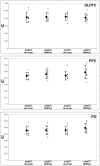The role of corpus callosum development in functional connectivity and cognitive processing
- PMID: 22870191
- PMCID: PMC3411722
- DOI: 10.1371/journal.pone.0039804
The role of corpus callosum development in functional connectivity and cognitive processing
Abstract
The corpus callosum is hypothesized to play a fundamental role in integrating information and mediating complex behaviors. Here, we demonstrate that lack of normal callosal development can lead to deficits in functional connectivity that are related to impairments in specific cognitive domains. We examined resting-state functional connectivity in individuals with agenesis of the corpus callosum (AgCC) and matched controls using magnetoencephalographic imaging (MEG-I) of coherence in the alpha (8-12 Hz), beta (12-30 Hz) and gamma (30-55 Hz) bands. Global connectivity (GC) was defined as synchronization between a region and the rest of the brain. In AgCC individuals, alpha band GC was significantly reduced in the dorsolateral pre-frontal (DLPFC), posterior parietal (PPC) and parieto-occipital cortices (PO). No significant differences in GC were seen in either the beta or gamma bands. We also explored the hypothesis that, in AgCC, this regional reduction in functional connectivity is explained primarily by a specific reduction in interhemispheric connectivity. However, our data suggest that reduced connectivity in these regions is driven by faulty coupling in both inter- and intrahemispheric connectivity. We also assessed whether the degree of connectivity correlated with behavioral performance, focusing on cognitive measures known to be impaired in AgCC individuals. Neuropsychological measures of verbal processing speed were significantly correlated with resting-state functional connectivity of the left medial and superior temporal lobe in AgCC participants. Connectivity of DLPFC correlated strongly with performance on the Tower of London in the AgCC cohort. These findings indicate that the abnormal callosal development produces salient but selective (alpha band only) resting-state functional connectivity disruptions that correlate with cognitive impairment. Understanding the relationship between impoverished functional connectivity and cognition is a key step in identifying the neural mechanisms of language and executive dysfunction in common neurodevelopmental and psychiatric disorders where disruptions of callosal development are consistently identified.
Conflict of interest statement
Figures







References
-
- Tomasch J (1954) Size, distribution, and number of fibres in the human corpus callosum. Anat Rec 119: 119–35. - PubMed
-
- Bigler ED, Rosenstein LD, Roman M, Nussbaum NL (1988) The clinical significance of congenital Agenesis of the Corpus Callosum. Archives of Clinical Neuropsychology 3: 189–200. - PubMed
-
- Sanders RJ (1989) Sentence comprehension following agenesis of the corpus callosum. Brain Lang 37: 59–72. - PubMed
-
- Banich MT, Brown WS (2000) A life-span perspective on interaction between the cerebral hemispheres. Dev Neuropsychol 18: 1–10. - PubMed
-
- Paul LK (2004) Schieffer B, Brown WS (2004) Social processing deficits in agenesis of the corpus callosum: narratives from the Thematic Appreciation Test. Arch Clin Neuropsychol 19: 215–25. - PubMed
Publication types
MeSH terms
Grants and funding
LinkOut - more resources
Full Text Sources
Miscellaneous

